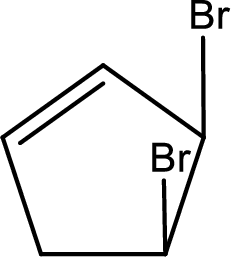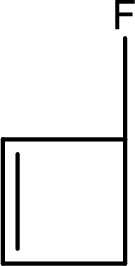
GEN ORGANIC CHM LL W/CONNECT
10th Edition
ISBN: 9781265180867
Author: Denniston
Publisher: MCG
expand_more
expand_more
format_list_bulleted
Concept explainers
Question
Chapter 11.2, Problem 11.2PP
(a)
Interpretation Introduction
Interpretation:
Given cycloalkene has to be named using

Concept Introduction:
A common nomenclature of naming organic compounds has been developed by IUPAC. By usage of this nomenclature or rules, memorizing of names of organic compounds is not necessary.
IUPAC rules for naming cycloalkenes:
- The number of carbon atoms present in the ring is counted and the name of the
alkane that has the same number of carbon atoms is given by adding prefix “cyclo-” to the alkane name. Suffix “-ane” is changed as “-ene”. - The double bond that is present in the ring is given always the number 1.
- If the ring is substituted, then the names of the group or atoms have to be placed before the name of cycloalkene.
- If the ring contains more than one substituent, then the numbers has to be used in a way that it gives the lowest position for the substituents following position 1 for the double bond.
(b)
Interpretation Introduction
Interpretation:
Given cycloalkene has to be named using IUPAC nomenclature.

Concept Introduction:
Refer part (a).
(c)
Interpretation Introduction
Interpretation:
Given cycloalkene has to be named using IUPAC nomenclature.

Concept Introduction:
Refer part (a).
(d)
Interpretation Introduction
Interpretation:
Given cycloalkene has to be named using IUPAC nomenclature.

Concept Introduction:
Refer part (a).
Expert Solution & Answer
Want to see the full answer?
Check out a sample textbook solution
Chapter 11 Solutions
GEN ORGANIC CHM LL W/CONNECT
Ch. 11.2 - Name each of the following alkenes and alkynes...Ch. 11.2 - Prob. 11.2PPCh. 11.2 - Prob. 11.1QCh. 11.2 - Prob. 11.2QCh. 11.3 - Prob. 11.3PPCh. 11.3 - Prob. 11.4PPCh. 11.3 - Prob. 11.5PPCh. 11.3 - Prob. 11.3QCh. 11.3 - Prob. 11.4QCh. 11.3 - Prob. 11.5Q
Ch. 11.3 - Draw each of the cis-trans isomers in Question...Ch. 11.3 - Prob. 11.7QCh. 11.3 - Prob. 11.8QCh. 11.5 - Prob. 11.6PPCh. 11.5 - Prob. 11.7PPCh. 11.5 - Prob. 11.9QCh. 11.5 - Write balanced equations for the hydrogenation of...Ch. 11.5 - Prob. 11.11QCh. 11.5 - Prob. 11.12QCh. 11.5 - Prob. 11.8PPCh. 11.5 - Prob. 11.13QCh. 11.5 - Prob. 11.14QCh. 11.5 - Prob. 11.15QCh. 11.5 - Prob. 11.16QCh. 11.5 - Prob. 11.9PPCh. 11.5 - Prob. 11.17QCh. 11.5 - Prob. 11.18QCh. 11.5 - Prob. 11.19QCh. 11.5 - Prob. 11.20QCh. 11.5 - Write a balanced equation for the hydrobromination...Ch. 11.6 - Name the following compounds using the IUPAC and...Ch. 11.6 - Prob. 11.21QCh. 11.6 - Prob. 11.22QCh. 11 - Prob. 11.23QPCh. 11 - Prob. 11.24QPCh. 11 - Prob. 11.25QPCh. 11 - Prob. 11.26QPCh. 11 - Prob. 11.27QPCh. 11 - Prob. 11.28QPCh. 11 - Prob. 11.29QPCh. 11 - Prob. 11.30QPCh. 11 - Prob. 11.31QPCh. 11 - Prob. 11.32QPCh. 11 - Prob. 11.33QPCh. 11 - Prob. 11.34QPCh. 11 - Prob. 11.35QPCh. 11 - Prob. 11.36QPCh. 11 - Prob. 11.37QPCh. 11 - Prob. 11.38QPCh. 11 - Prob. 11.39QPCh. 11 - Prob. 11.40QPCh. 11 - Prob. 11.41QPCh. 11 - Prob. 11.42QPCh. 11 - Prob. 11.43QPCh. 11 - Prob. 11.44QPCh. 11 - Prob. 11.45QPCh. 11 - Prob. 11.46QPCh. 11 - Which of the following alkenes can exist as...Ch. 11 - Prob. 11.48QPCh. 11 - Prob. 11.49QPCh. 11 - Prob. 11.50QPCh. 11 - Prob. 11.51QPCh. 11 - Prob. 11.52QPCh. 11 - Prob. 11.53QPCh. 11 - Prob. 11.54QPCh. 11 - Prob. 11.55QPCh. 11 - Prob. 11.56QPCh. 11 - Prob. 11.57QPCh. 11 - Prob. 11.58QPCh. 11 - Prob. 11.59QPCh. 11 - Prob. 11.60QPCh. 11 - Prob. 11.61QPCh. 11 - Prob. 11.62QPCh. 11 - Prob. 11.63QPCh. 11 - Prob. 11.64QPCh. 11 - Prob. 11.65QPCh. 11 - Prob. 11.66QPCh. 11 - Prob. 11.67QPCh. 11 - Prob. 11.68QPCh. 11 - Prob. 11.69QPCh. 11 - Prob. 11.70QPCh. 11 - Prob. 11.71QPCh. 11 - Prob. 11.72QPCh. 11 - Prob. 11.73QPCh. 11 - Prob. 11.74QPCh. 11 - Prob. 11.75QPCh. 11 - Prob. 11.76QPCh. 11 - Prob. 11.77QPCh. 11 - Prob. 11.78QPCh. 11 - Prob. 11.79QPCh. 11 - Prob. 11.80QPCh. 11 - Prob. 11.81QPCh. 11 - Prob. 11.82QPCh. 11 - Prob. 11.83QPCh. 11 - Write an equation for the addition reaction that...Ch. 11 - Prob. 11.85QPCh. 11 - Draw the structure of each of the following...Ch. 11 - Prob. 11.87QPCh. 11 - Prob. 11.88QPCh. 11 - Prob. 11.89QPCh. 11 - Prob. 11.90QPCh. 11 - Prob. 11.91QPCh. 11 - Prob. 11.92QPCh. 11 - Draw each of the following compounds, using...Ch. 11 - Prob. 11.94QPCh. 11 - Prob. 11.95QPCh. 11 - Prob. 11.96QPCh. 11 - Prob. 11.97QPCh. 11 - Prob. 11.98QPCh. 11 - Prob. 11.99QPCh. 11 - Prob. 11.100QPCh. 11 - Prob. 11.101QPCh. 11 - Prob. 11.102QPCh. 11 - Prob. 11.103QPCh. 11 - What biological molecules contain purine rings?
Ch. 11 - Prob. 1MCPCh. 11 - Prob. 3MCPCh. 11 - Prob. 5MCPCh. 11 - Prob. 6MCPCh. 11 - Prob. 7MCPCh. 11 - Prob. 8MCPCh. 11 - Prob. 9MCPCh. 11 - Prob. 10MCP
Knowledge Booster
Learn more about
Need a deep-dive on the concept behind this application? Look no further. Learn more about this topic, chemistry and related others by exploring similar questions and additional content below.Recommended textbooks for you
 ChemistryChemistryISBN:9781305957404Author:Steven S. Zumdahl, Susan A. Zumdahl, Donald J. DeCostePublisher:Cengage Learning
ChemistryChemistryISBN:9781305957404Author:Steven S. Zumdahl, Susan A. Zumdahl, Donald J. DeCostePublisher:Cengage Learning ChemistryChemistryISBN:9781259911156Author:Raymond Chang Dr., Jason Overby ProfessorPublisher:McGraw-Hill Education
ChemistryChemistryISBN:9781259911156Author:Raymond Chang Dr., Jason Overby ProfessorPublisher:McGraw-Hill Education Principles of Instrumental AnalysisChemistryISBN:9781305577213Author:Douglas A. Skoog, F. James Holler, Stanley R. CrouchPublisher:Cengage Learning
Principles of Instrumental AnalysisChemistryISBN:9781305577213Author:Douglas A. Skoog, F. James Holler, Stanley R. CrouchPublisher:Cengage Learning Organic ChemistryChemistryISBN:9780078021558Author:Janice Gorzynski Smith Dr.Publisher:McGraw-Hill Education
Organic ChemistryChemistryISBN:9780078021558Author:Janice Gorzynski Smith Dr.Publisher:McGraw-Hill Education Chemistry: Principles and ReactionsChemistryISBN:9781305079373Author:William L. Masterton, Cecile N. HurleyPublisher:Cengage Learning
Chemistry: Principles and ReactionsChemistryISBN:9781305079373Author:William L. Masterton, Cecile N. HurleyPublisher:Cengage Learning Elementary Principles of Chemical Processes, Bind...ChemistryISBN:9781118431221Author:Richard M. Felder, Ronald W. Rousseau, Lisa G. BullardPublisher:WILEY
Elementary Principles of Chemical Processes, Bind...ChemistryISBN:9781118431221Author:Richard M. Felder, Ronald W. Rousseau, Lisa G. BullardPublisher:WILEY

Chemistry
Chemistry
ISBN:9781305957404
Author:Steven S. Zumdahl, Susan A. Zumdahl, Donald J. DeCoste
Publisher:Cengage Learning

Chemistry
Chemistry
ISBN:9781259911156
Author:Raymond Chang Dr., Jason Overby Professor
Publisher:McGraw-Hill Education

Principles of Instrumental Analysis
Chemistry
ISBN:9781305577213
Author:Douglas A. Skoog, F. James Holler, Stanley R. Crouch
Publisher:Cengage Learning

Organic Chemistry
Chemistry
ISBN:9780078021558
Author:Janice Gorzynski Smith Dr.
Publisher:McGraw-Hill Education

Chemistry: Principles and Reactions
Chemistry
ISBN:9781305079373
Author:William L. Masterton, Cecile N. Hurley
Publisher:Cengage Learning

Elementary Principles of Chemical Processes, Bind...
Chemistry
ISBN:9781118431221
Author:Richard M. Felder, Ronald W. Rousseau, Lisa G. Bullard
Publisher:WILEY